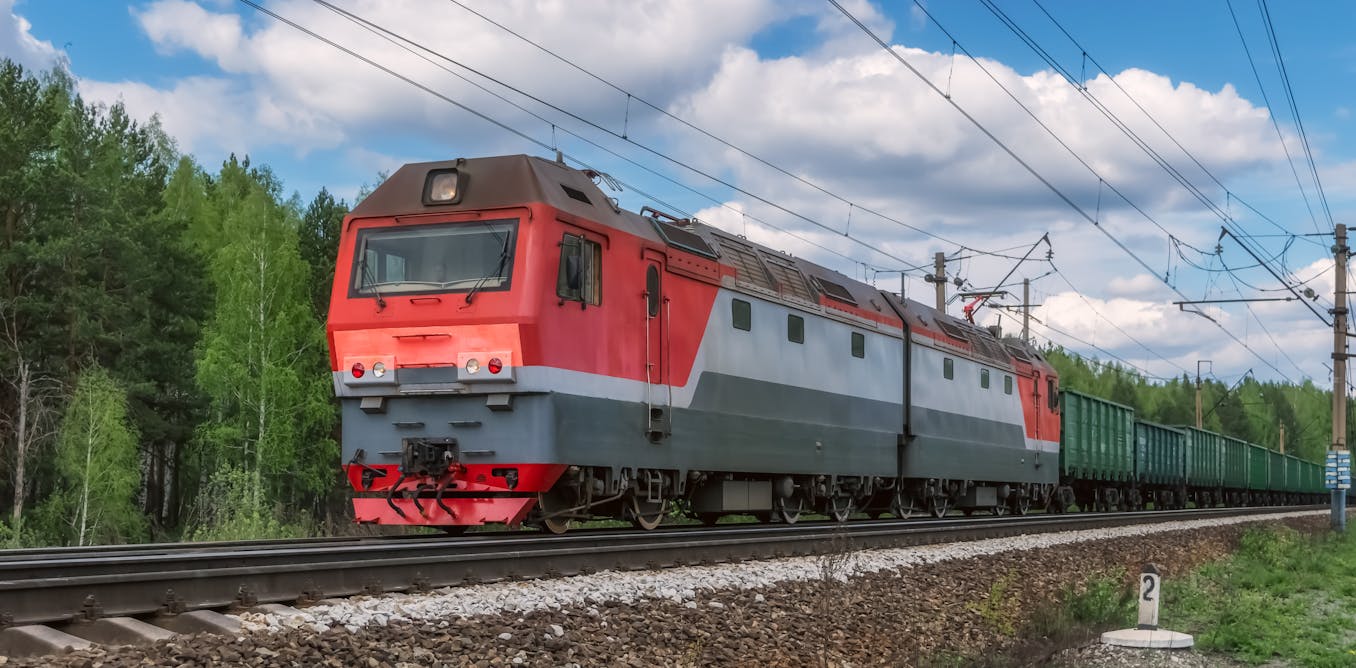- cross-posted to:
- [email protected]
- cross-posted to:
- [email protected]
What really annoys me about this is that we had good rail infrastructure here in Germany, then it got privatized in the 90s, which made it shit over the last few decades, which means everything is transported via trucks now, which just puts those costs onto the more expensive roads. Like, that was just a bad decision even before the public cared about climate change.
It’s the whole neoliberal “sell everything not nailed down” approach to government infrastructure that was taken right across the Western world, even from ostensibly left-wing parties. Turns out you can get some cheap money from selling things off and get to brag about a surplus. Who cares that you eventually run out of things to sell and are left with expensive infrastructure and services that only private companies can profit from, that’s a future government’s problem!
Sell things that you’re making profit off of to make money quickly instead of making money long term? Genius!
deleted by creator
We all love complaining but when looking at the big picture, Germany still has great rail. Could it be better? Yes, it’s wasted potential. But as someone from southern Europe, this is great. But can’t wait to move to a better place.
Cries in canadian rail
When the train gets stuck behind a freight train and has to go 20 km/h
Since the war in Ukraine started it has become very common for fuel trains to take priority over passenger trains and delay everyone in Germany. Somehow they can’t plan ahead for it.
They can, they are choosing not to. We have that same problem in the US. Legally, freight is supposed to yield to passenger rail, but private companies don’t give a fuck so they did everything they could to avoid complying and now they basically never comply and nothing ever happens to them
I always find this so funny, like people are talking “needing to innovate to solve the climate crisis”. like, FFS, WE’VE HAD ELECTRIC TRAINS FOR OVER 100 YEARS!
They don’t even need batteries! They just need a power line and a little hook!
Adam something has been saying this for ages now… We have the solutions, the problem is greed
Adam Something is a dick though. His urbanism-videos are well-meant but they’re mostly him stating obvious facts angrily, and he’s openly a European militarist and a Russophobe.
Edit: found this post saying “nuclear war actually isn’t that bad guys”
Aren’t we all Russophobes at the moment? I think you need to be more specific.
Russophobe = racist towards Russians. You can be critical of the proto-fascist regime in modern Russia without engaging in racism towards Russian people themselves, in the same way that I condemn the American government and institutions for the invasion of Iraq without blaming the citizens and without cheering every time an American soldier was killed.
Can’t remember Adam something saying anything bad against Russians except Putin and his cronies… You seem to have anyone to pick with him and started exaggerating stuff
He was posting memes in his community tab and that of his second channel (Adam Something else), some of which he later deleted, saying that “nuclear war isn’t that bad”, promoting a service where you could pay so that Ukrainian military would write memes on artillery shells and record themselves firing them, calling Russians “orcs”, etc.
If you don’t think that’s wrong, imagine a YouTuber posting the website of the Iraqi military where you could pay to write memes in RPG-7 rounds fired to American soldiers during the invasion of Iraq, calling all americans “orcs” and wishing that nuclear weapons are used against them.
I’m not American… But in both cases, Americans and Russians are the unprovoked invasion force, they may not be orcs but they play the part
I’m not American either, but rather than laughing at the death of American soldiers, I’m sad that young men were deceived by their institutions and governments (or outright conscripted) into inflicting suffering and death and suffering it themselves.
Idk, when I was in Mississippi they were cutting down giant live-oaks to make room for a shitty gas station. It was like watching the orcs rip out the trees around Isengard.
Wait… Less rolling resistance is superior to more rolling resistance? How come?
Different efficiency in the engines? Energy sources? Manufactoring costs?
Operational costs? Personell costs? Infrastructure costs?
Thanks for posting this. We knew this for a long time, didn’t we? How did Trucks ever win out in long range land-based transport?
Massive subsidies.
Railroads have to pay to maintain the tracks they run on. They also have to pay property tax for owning the rails and land.
Trucks run on public highways that the government pays for. Trucks do pay taxes, but not nearly as much as they would need to to cover the wear they cause to the roads.
If all freight had to fully fund their own infrastructure, overland cargo would be almost exclusively carried by rail, even more so if they had to cover the damages of their carbon and particulate emissions.
To add to this for people who don’t know, road wear scales at a power of 4 with the weight.
So if a vehicle is 2x as heavy it causes 16x as much damage to the road
The average car weighs approximy 4000 lbs.
The ford f-150 is about 5000 lbs, which causes 2.4 times the road wear as the average car.
A big rig with no trailer weighs about 20,000 lbs, which causes 625 times the road wear as the average car.
An truck with an empty trailer weighs 30,000 lbs, causing 3,200 times the road wear as the average car.
A truck with a medium load weighs about 55,000 lbs, which causes 36,000 times the road wear.
A truck operating at the federal weight limit of 80,000 lbs causes 160,000 times the road wear as the average car.
But it gets worse. The average car driver drives 13,000 miles per year. Long haul trucks drive an average of 100,000 miles per year. They are commercial vehicles driving during most of a workday. Trucks drive 8 times further.
In comparison to the average car, a truck hauling medium loads causes around 288,000 times more road wear than a normal passenger car.
Trucks cost more to register than passenger cars, they pay slightly more in tax, but nowhere near the 288,000 times they should.
Trucks are economonically viable entirely due to the massive subsidies they get for being grossly undercharged for the roads they run on.
Edit: On reflection my numbers are probably too high, and extrapolating the available studies to big rigs is probably unreasonable. Trucks have per axle/tire weight limits. Bigger trucks have more axles. A truck with twice the weight distributed across twice the number of wheels will probably be closer to twice the wear than what I predicted. Not enough to negate the conclusion, but real numbers are probably not quite as high as I predicted.
Part of the other problem of trucks is they go across many borders, from cities to countries, but are not paying taxes for each specific road. This means a truck from Country A can pay the majoirty of its taxes to country A, despite spending more of its time on country B roads.
In most of Europe you need to pay a fee to drive on public roads, sometimes only motorways
There are some toll roads in north america. Mostly motorways or bridges. People pay a registration to put their car on the road and pay taxes on gas. Many assume this covers their share of the cost of the road and don’t realize that driving is massively subsidized.
Throw that in there with factory farming, fossil fuels, airlines, and a bunch of other things that the government shovels money into.
Adding to your edits, you have to divide the weight by the number of tires before raising it to the 4th power then you multiply that new number by the number of tires. That will give you more accurate numbers
Electric cars come to mind.
With current technology, an EV might be expected to be 20% heavier than a comparable ICE car. 1.2^4 = 2. Twice the road west might look like a lot, until you realize just how much road wear is dominated by bigger vehicles. The neighbor in the bro-dozer that’s twice as heavy, so sixteen times the road wear. Then again that one semi driving by wearing the road like thousands of cars, and that’s before you count the fixed axle rear wheels destroying the pavement as the tires move laterally on turns.
While an EVs weight is technically a problem for road wear and we do need to work on it, it’s far dwarfed by existing overly large vehicles. We have bigger things to worry about. Literally, in this case.
Big vehicles do cause damage for sure. Does the frequency of repeated force caused by the exponentially larger number of EVs on the road year over year cause roads to wear out faster though? If so, it seems like cause for more than a shrug of concern.
I do agree it’s an issue, but it’s a smaller issue than the ever ending creasing adoption of full sized trucks for personal use, and both are smaller impact than semis. I’m all for efficiency standards that encourage reduced vehicle weight. I’m all for weight based tolls or taxes so all vehicles pay a more fair share of the damage they do. But it’s disingenuous to blame EVs
Fair! Not blaming them fwiw.
NAZIs, I guess?
(No, seriously: Nazi Germany invented Autobahns to help blitzkrieg tactics, then Eisenhower saw the strategic advantage and copied them to create the Interstate Highway System, then everyone else copied the US.)
No they didn’t, they took credit for the previous administration: https://www.dw.com/en/the-myth-of-hitlers-role-in-building-the-autobahn/a-16144981
While the Nazi’s rolled out the Autobahn, it had little to no military significance. Interior movements biased trains to reduce fuel costs. And how exactly would an interior road help a blitzkrieg tactic into another country?
By bringing quickly the men and resources needed at the border with little to no time for the defenders to prepare?
Okay. But wouldn’t a road to the border be something thats guarded? Seems like if you want to sneak attack your enemy you would choose a less obvious route, like through the woods or placing a military bridge across a river, rather than down a road to the border.
I don’t know I have only a limited experience in invading foreign nations.
As a guy who knows nothing about much. I loves me some trains. More trains please.
Coming from a transport modeller, the title of this article is incredibly flawed, and the write up should row back a bit.
The study itself seems great; looking in detail at the carbon cost of a transport mode throughout its lifecycle. However, it emphatically shouldn’t be used to inform transport policy on its own.
This will have a focus on the UK, as this is what I’m familiar with.
Rail schemes, particularly heavy rail, has massively high start up costs due to all the engineering that has to go in place (because if rail goes wrong, it tends to go very wrong, and so the rail industry and legislation is naturally very cautious).
We don’t just need to get to net zero; we need to get to net zero fast. Bus rapid transit is much faster to get off the ground, and can be electrified by putting batteries in and having quick charging at certain stops and, crucially, has a capx that a cash strapped local government is more likely to swallow.
BRT is easier to get going, but still is way less effecient than an electrified tram. Trams usually won’t need to charge as they can be wired full time or charge on sections that are wired.
Local governments are cash strapped because of our ridiculous roads (north american perspective). The average neighbourhood doesn’t generate enough taxes to maintain their infrastructure. We need to fix that as well through changing the way we build and tax land in our cities.
OK so a massive tax hike to pay for it but how much coverage is the Tram network going to have? And is it a 24 hour service? What capacity should it have, how many people will need to travel at peek times?
If you want to cover everywhere and serve everyone when needed then you need a big network of trams that sync somewhat conveniently for passengers, due to the nature of the infrastructure this means you’ll be running a lot of unused capacity most the time especially if usage patterns change.
This is why busses are more popular with transport authorities outside high volume consistent use routes, the bus routes in my area change regularly to match demand. There’s also a considerable portion of journeys that are unsuitable for tram or bus, taking trash to the tip or collecting six small trees for example.
There are solutions to these issues but we need to be aware of the problems that need solving and work towards intermediary steps so transition is possible. What we build now should be working towards an integrated transit network that’s able to evolve towards efficient and complete mass transit where and when appropriate. Trams have places they work really well, we should be identifying them and highlighting them, pushing for trams everywhere is a mistake though.
Anywhere a BRT is viable is likely able to support a tram. Longer distances than that and light rail starts becoming feasable. Long hauls can be done by high speed rail.
A no point did i say to rip out every car lane so you can still do your landscaping and dump runs.
A 24 hour service would be nice where demand can support it. Not every run has to be profitable, some runs will always be busier than others but transit shouldn’t be about profits, it should be about connectivity.
deleted by creator




